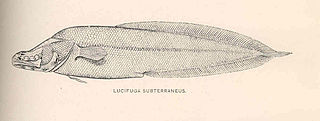
The viviparous brotulas form a family, the Bythitidae, of ophidiiform fishes. They are known as viviparous brotulas as they generally bear live young, although there are indications that some species do not. They are generally infrequently seen, somewhat tadpole-like in overall shape and mostly about 5–10 cm (2–4 in) in length, but some species grow far larger and may surpass 60 cm (2 ft).

Lucifuga is a genus of viviparous brotulas. Most of the species are native to caves and sinkholes in Cuba and the Bahamas; L. inopinata from deep water off the Galápagos Islands is the only exception. The four species rated by the IUCN are all considered vulnerable. The largest species in the genus reaches about 15 cm (5.9 in) in length.

Ogilbia is a genus of viviparous brotulas. The generic name honours the Australian naturalist James Douglas Ogilby (1853-1925), for his contribution to the knowledge of the fishes of Australia.

Saccogaster is a genus of viviparous brotulas. They are found in the western Atlantic and Indo-Pacific.

Bidenichthys is a genus of viviparous brotulas.
Dermatopsis is a genus of viviparous brotulas.
Dermatopsoides is a genus of viviparous brotulas.
Diancistrus is a genus of viviparous brotulas.
Dipulus is a genus of viviparous brotulas.
Majungaichthys is a genus of viviparous brotulas native to the western Indian Ocean. The generic name refers to Majunga in Madagascar where the type was collected.
Mascarenichthys is a genus of viviparous brotulas. They have mostly been collected from the region of Mascarene Plateau in the Indian Ocean and this is referred to in their generic name.
Microbrotula is a genus of viviparous brotulas.
Ogilbichthys is a genus of viviparous brotulas found in the central-western Atlantic Ocean and the Caribbean Sea. The generic name refers to the resemblance of these fish to those in the genus Ogilbia, a name honours the Australian naturalist James Douglas Ogilby (1853-1925), combined with ichthys which means "fish" in Greek.
Paradiancistrus is a genus of viviparous brotulas.
Timorichthys is a genus of viviparous brotulas so far known from the East China Sea and the Timor Sea.
Zephyrichthys barryi is a species of viviparous brotula found in the Indian Ocean waters around western Australia. This species grows to a length of 5.9 centimetres (2.3 in) SL. This species is the only known member of its genus. The etymology of the name is that the generic name is a compound of zephrys which is Greek for the west wind and refers to the species western Australian range and ichthys, "fish". The specific name honours in the ichthyologist J. Barry Hutchins of the Western Australian Museum (WAM) for his contribution to the knowledge of Australian fishes and for allowing the describers of Z. barryi access to the museum's collections.

Brosmophycinae is a subfamily of the viviparous brotulas. They are divided from the subfamily Bythitinae by having the dorsal fin, caudal fin and anal fin all separate whereas they are joined in the Bythitinae. It is divided into the tribes Dinematichthyini and Brosmophycini, with the first having hardened genital claspers and the second soft genital claspers. A review in 2016 elevated the Dinematichthyini to the status of a family the Dinematichthyidae.

Bythitinae is a subfamily of viviparous brotulas, one of the two subfamilies in the family Bythitidae. This subfamily is characterised by having the dorsal, caudal and anal fins combined. They are mostly found in temperate to tropical seas, from reefs to the benthopelagic zone, but some species from the North Atlantic Ocean occur in into Arctic waters.
Dinematichthyidae is a family of fishes belonging to the order Ophidiiformes.
Mascarenichthys heemstrai is a ray-finned fish species from the family of Bythitidae in the genus of Mascarenichthys. The scientific name of the species was first published in 2007 by Schwarzhans & Møller, It was named after Phil Heemstra, a notable ichthyologist.





